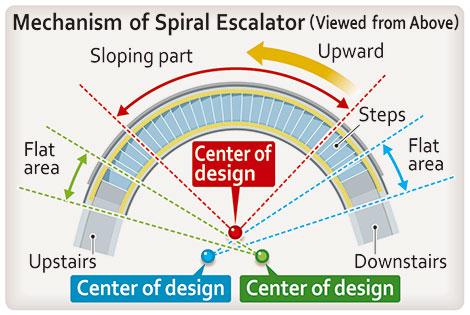Do you know about the “spiral escalators” that go up and down along a curved path like a spiral staircase? These escalators, which leisurely go up and down while detouring in the shape of a semicircle, makes the scenery before one’s eyes change like a panorama, allowing its riders to enjoy a distinctive feeling. There are only 91 of these escalators in the world, manufactured by just one Japanese company.

Spiral escalator installed in Las Vegas, United States, at Forum Shops ©Shinkenchiku-sha Co., Ltd.
Thought unrealizable before

Spiral escalator installed at the front entrance of Mitsubishi Electric Inazawa Works
“The desire to make a new and interesting escalator that nobody else has realized”—This was the wish of the company’s engineers that launched the development of the spiral escalator in 1982.
Escalator was first introduced to the world at the Paris Exposition in 1900, although the idea of moving steps on a curved path existed from before. But engineers back then could not make a device that would operate safely. Why not? The reason is said to be because they thought both straight lines and curves operated under the same principle.
Struggles of the Engineers
To begin with, in standard escalators, the steps on which people stand are operated by a mechanism in which the axes of two aligned rows of chains move up and down. These steps simply move together with the chain—at first they are flat, then they make a slope, and they become flat again at the end. However, in curved escalators, each step moves in a more complex manner, not only moving up and down but also tracing the shape of semicircle. In the past, some experts believed that escalators will not move in a curve unless the step-moving chains could freely expand and contract.
Overturning Common Sense

Image of a spiral escalator operated while moving the three center points
It is said that Japanese engineers conducted numerous calculations over and over again, drawing out over 1000 blueprints, in order to solve this difficult problem. Eventually, they found out that the blueprint should be drawn by providing separate center points to the three parts with varying slopes. This thought process was based on making a device just by changing the length of the chains, without requiring them to be expanded or contracted. Overturning the common sense of drawing a blueprint based on the thought that there is only one center because the escalator moves in the shape of a circle and devising a moving center led to the advancement of technology.